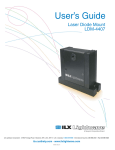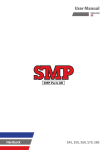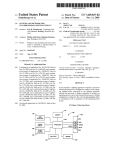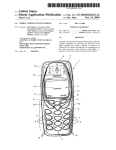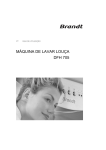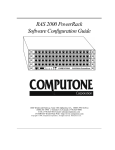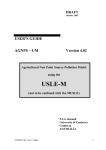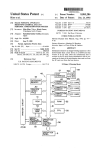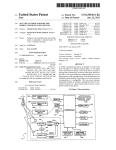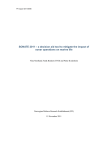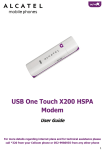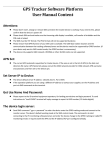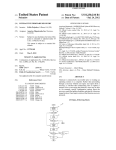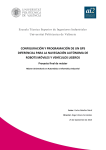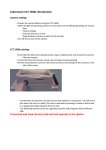Download Mobile communication terminal
Transcript
US007373120B2
(12) Ulllted States Patent
(10) Patent N0.:
Messel et al.
(54)
(45) Date of Patent:
MOBILE COMMUNICATION TERMINAL
Inventors:
Giovanni
.
Messel’
Ferranti,
Copenhagen
Broenshoej
_
(DK);
.
5,408,268 A *
4/1995 Shipp ....................... .. 348/269
5,946,636 A *
8/1999
Uyeno et a1. ......... .. 455/566
6,771,938
,
,
B2 *
8/2004
Lustila
1821121911
all e eta.a1.
~ ~ ~.
Tun.” Elomaa.’ Tampele (171)’ Tapam
7,096,045 B2*
8/2006 Yoshinaga .
7 , 103 , 389 B2 *
9/2006 Sh.ibata
_
_
_
(73)
Asslgneei Nokla COFPOYatIOIIS ESPO0 (F1)
(*)
Nonce:
_
_
_
(22)
455/566
455/565
(51)
Nagase ........... ..
7/2002 Engstrom et a1. ......... .. 455/566
A1*
9/2002
2002/0183098 A1*
12/2002
patent is extended or adjusted under 35
2003/0002682 A1 *
Sakai et a1.
.......... ..
Lee et a1. . . . . . .
379/142.17
. . . . .. 455/566
1/2003 Smith et a1. ................. .. 381/2
FOREIGN PATENT DOCUMENTS
Prior Publication Data
US 2004/0204125 A1
455/567
3/2002
A1*
2002/0126815
Mar. 13, 2002
(65)
..... .. 455/567
.... ..
2002/0037751
Subject to any dlsclalmer, the term of thls
Appl. N0.: 10/096,491
Filed:
.
3/2002 Kume
2002/0098876 A1*
_
~ .~
2002/0032044 A1*
USC‘ 1540’) by 523 days‘
(21)
May 13, 2008
Joklnen, Helsinki (Fl), Michael
McKay’ Calabases, CA (Us)
_
US 7,373,120 B2
Oct. 14, 2004
Int CL
EP
1109380
EP
1168775
6/2001
1/2002
GB
2361798
10/2001
GB
JP
WO
2377125
12/2002
1177630 A1 * 6/2001
9744912
11/1997
WO
9918590
4/1999
* cited by examiner
H04B 1/18
(2006-01)
Primary Examiner4CongVan Tran
(52)
US. Cl. ............................... .. 455/157.2; 455/159.1
(58)
Field of Classi?cation Search .............. .. 455/566,
('74) Allgrney) Agent, or FirmiFoley and Lardner LLP
455/567, 575, 90.1, 90.2, 90.3, 550.1, 74.1,
(57)
455/344,157.2,156.1,159.1,159.2,154.2,
455/158'2, 1601, 5751; 37967601’ 368,
A
379/14217
See application ?le for complete search history. '
(56)
References Cited
U.S. PATENT DOCUMENTS
3,798,638 A
ABSTRACT
b.1
. t. t
. 1 h. h. 1 d
1
1.
mo iecommunica 1on ermina W 10 me u esap ura 1ty
of lights, apparatus for controlling the activation of the
lights, apparatus for storing a number of sequences of
activation of the lights, and apparatus for assigning one of
the stored sequences of the activation of the lights to a
particular event in the mobile communication terminal.
3/1974 Goldschmied
20 Claims, 9 Drawing Sheets
I
is a light
sequence assigned
{0 event ?
relneved SEQUENCE
signal to end
ensfalion recalved '2
U.S. Patent
May 13, 2008
Sheet 1 0f 9
0
14
HI“
15
f’..
_
US 7,373,120 B2
\
°°
'"I\
Q
I‘
>/
KIA
12—N.
3
Operator
11'
11
nu
8
f
10~
8’
---"/
9
“*7
\
Q
Q
2
Nam s
“
10'
///
9,
01
I, ~
13’
13
U.S. Patent
May 13, 2008
Sheet 2 0f 9
US 7,373,120 B2
U.S. Patent
May 13, 2008
Sheet 3 0f 9
US 7,373,120 B2
U.S. Patent
May 13,2008
Sheet 4 0f 9
20l
does event
occur ?
202
is a light
sequence assigned
to event?
retrieve
sequence
203
assigned
to event
generate signal in
accordance with
retrieved sequence
205
signal to end
eneration received 7
Fig. 1d
US 7,373,120 B2
U.S. Patent
May 13, 2008
Sheet 5 0f 9
US 7,373,120 B2
9. Messages
Operator
I
‘i0. Light tunes
11. Light organ
12. Call divert
Menu
Select
Names
Back
/
7
2.1
2.2
incoming SMS
Highscore
Activate
Options
__> Ongoing call
Calendar note
Exit
/
/
2.3
2.4
4.1
Retrieve from library
Select
Back
2.5
7
i
3.1
Fig. 2
U.S. Patent
May 13, 2008
Sheet 6 0f 9
Enter sequence
_
Bri htness
1. Key pad —green
6. Right side - green
2. Display - white
7. Top area - blue
3. Left side - red
8. Logo - red
4. Left side - blue
5. Right side - red
9.
OK
US 7,373,120 B2
,
Mfdd|e
I
Hlgh
Logo - yellow
Clear
OK
/
Back
,1
3.1
3.2
Duration
ATTRIBUTES
0 3 sec
M
w
amp own
0'9 sec
1,2 sec
Fuli power
Intermittent
lsophase
OK
Options
0K
/
3.4
3.3
p|ay
A
Back
/
Name:
glscar!
—>
0K
Back
/
OK
Back
/
3.5
3.6
Fig. 3
U.S. Patent
May 13, 2008
Sheet 7 0f 9
US 7,373,120 B2
1. Light tune i
2. Light tune 2
3. Light tune 3
4. Light tune 4
Assign
Options
4.1
Play
m
Phone number:
Edit
Discard
A
Rename
0K
Back
Search
Back
Phone number:
Sending light tune
21937015
OK
Clear
Cancel
Fig. 4
U.S. Patent
May 13, 2008
.
Sheet 8 0f 9
.
Play
Ll ht tune recelved
g
Options
US 7,373,120 B2
_; Save
Discard
Exit
OK
I
/
5.1
5.2
_
Details
F lrework
p|a
3-3-2-1-2-2-2-5-4-4
@
Sender: SMS-Broadcast club
Dlscard
Options
Back
OK
Back
/
5.3
5.4
Save in position:
08 09 10 11“
OK
Back
/
5.5
Fig. 5
U.S. Patent
May 13, 2008
Sheet 9 0f 9
US 7,373,120 B2
Light Organ
Settings
Activate
M
m
k
Frequency ranges
Record tune
—
OK
Back
OK
Back
/
/
6.1
6.2
Audio source
Frequency ranges
Radio
Audio player
OK
Back
OK
Options
7
/
6.3
6.4
Assign LED
1. Key pad —green
-
-
6. Right side - green
2. Display — white
Recording light tune
—>
End
7. Top area - blue
3. Left side-red
8. Logo- red
4. Left side - blue
5. Right side — red
9.
0K
/
Back
f
65
6.6
Fig. 6
Logo - yellow
US 7,373,120 B2
1
2
MOBILE COMMUNICATION TERMINAL
According to an embodiment, the means for composing
sequences of activation of the lights comprises a keypad, a
display, and means for displaying on the display an indica
tion Which keys of the keypad need to be pressed to compose
a sequence of activation of the lights.
The present invention relates to mobile communication
terminals that comprise a plurality of lights. In particular, the
present invention relates to mobile communication terminals
in Which a sequence for the activation of the lights may be
stored. The present invention relates further to a method of
composing a sequence of activation of lights on a mobile
communication terminal. The present invention relates in
particular to a method of composing a sequence of activation
of lights on a mobile communication terminal in Which said
mobile communication terminal comprises a display, a key
pad, lights and a memory.
Advantageously, the sequence of activation of the lights is
synchronized With a vibrator of the mobile communication
terminal, so that a combined silent signaling is possible.
The mobile communication terminal lights may be LEDs
and/or electro luminescent foils and/or electro luminescent
strings and/or optical ?bers.
It is another object of the present invention to provide a
mobile communication terminal of the kind referred to
initially, Which alloWs a broader use of the lights. This object
BACKGROUND ART
is achieved in accordance With claim 11 by providing the
mobile communication terminal With means for transform
Mobile communication terminals depend in their func
tionality highly on the effectiveness of the user interface.
One aspect of the user interface is the ability to notify the
user. Such noti?cation has in the past mainly been based on
audio signals. In recent years the ability to notify the user of
incoming calls the user With a vibrator has become popular.
GB 2 361 798 discloses a mobile communication terminal
in Which combinations of display colors or lighting notify an
incoming call. The data for changes in lighting is stored in
a RAM. A light driver independently drives the plurality of
ing an audio signal into a control signal for activation of the
lights.
20
Advantageously, the audio signal is provided by a micro
phone in the mobile communication terminal, and/or by a
digital audio player in the mobile communication terminal
25
and/or by a radio in the mobile communication terminal
and/or by a memory in the mobile communication terminal
in Which ringing tunes are stored. With the microphone
activated, eg in a discotheque or other place Where music
is played, the mobile communication terminal can be used as
a light organ.
Advantageously, the audio signal is divided into tWo or
30
more discrete frequency bands by ?lters, and the output of
the ?lters is used to activate the lights, preferably With a light
With a different color being assigned to each frequency band,
LEDs according to the data stored in the RAM When a call
is received.
DISCLOSURE OF THE INVENTION
On this background, it is an object of the present invention
to provide a mobile phone of the kind referred to initially,
and/or the intensity of the lights being modulated according
to the output level from the ?lter driving the light. Thus, the
Which alloWs a broader use of user noti?cation through
activation of lights. This object is achieved in accordance
light effects in response to the audio signal become more
35
With claim 1 by providing a memory that can store a
plurality of sequences for the activation of lights, and means
for selectively assigning a stored sequence to a particular
event in the mobile communication terminal. Thus, different
events, such as incoming calls, incoming calls from a
The mobile communication terminal may also comprise
means for recording and storing the activation of the lights
in response to the audio signal. Thus, the user does not have
to doWnload or enter the sequences of activation of the
40
particular caller or caller group, key lock, key unlock, poWer
on/olf, calendar alarm, incoming SMS, high score, Wake-up
alarm, battery status indication and signal strength indica
tion can be assigned a particular lighting sequence.
According to an embodiment, the means for selectively
assigning one of the stored sequences of the activation of the
lights to a particular event in the mobile communication
terminal comprises a keypad, a display, and means for
displaying on the display an indication Which keys of the
keypad need to be pressed to assign one of the stored
sequences of the activation of the lights to a particular event
in the mobile communication terminal.
Advantageously, the means for selectively controlling the
activation of the lights comprises means for controlling tie
color of the lights and/or for controlling the intensity level
lights, but may simply record, store and assign them to
different events. Preferably, the intensity level during the
activation of a light is also recorded.
It is another object of the present invention to provide a
method of composing a sequence of activation of lights on
45
a mobile communication terminal of the kind referred to
initially. This object is achieved in accordance With claim 18
by providing a method comprising the steps of:
50
displaying on the display a menu in Which the activity of
composing of a sequence of activation of lights can be
selected by pressing one or more keys of the keypad, and
When such keys have been pressed,
displaying on the display a menu in Which the sequence
of the activations of lights can be composed by pressing one
or more keys of the keypad, and
55
at Which the lights are activated. Thus the number of
storing the composed sequence of the activation of lights.
According to a preferred embodiment, the method further
comprises the step of-displaying on the display a menu in
variations in light sequences and the attractiveness of the
appearance is improved.
Which the color and/ or intensity in Which the lights are to be
activated can be selected by pressing one or more keys of the
The user interface may further comprise means for com
posing the sequences of activation of the lights. Thus, the
sophisticated.
60
keypad.
user can create his/her personal sequences. Preferably, the
The method may further comprise the step of displaying
means for composing sequences of activation of the lights
on the display a menu in Which the duration of an activation
one of the lights can be selected pressing one or more keys
alloWs the user to select the intensity level of a light to be
of the keypad. Advantageously, the method may further
activated, preferably as loW, middle, high, and/or alloWs the
user to select the duration of the activation of a light to be
activated, and/or alloWs selection of the timing betWeen
activations of the lights.
65
comprise the step of displaying on the display a menu in
Which a sequence of activation of lights can be saved to the
memory by pressing one or more keys of the keypad.
US 7,373,120 B2
4
3
According to another preferred embodiment, the method
BRIEF DESCRIPTION OF THE DRAWINGS
further comprises the step of displaying on the display a
In the folloWing detailed portion of the present descrip
menu in Which a stored sequence of activation of lights can
tion, the invention Will be explained in more detail With
reference to the exemplary embodiments shoWn in the
be retrieved form the memory by pressing one or more keys
of the keypad. Advantageously, the method may further
draWings, in Which
comprise the step of displaying on the display a menu in
Which the assignment of one of the stored sequences of
activation of lights to a particular event in the mobile
communication terminal can be selected by pressing one or
FIG. 1a is a diagrammatic vieW on a mobile communi
cation terminal according to the invention,
FIG. 1b is a vieW form on the back of a front cover With
integrated lights,
more keys of the keypad. Advantageously, the method may
further comprise the step of displaying on the display a menu
in Which a stored sequence of activation of lights can be send
to another mobile communication terminal by pressing one
or more keys of the keypad.
It is another object of the present invention to provide a
method of assigning a sequence of activation of lights on a
mobile communication terminal to a particular event in the
communication terminal. This object is achieved in accor
dance With the claims by providing a method of assigning a
FIG. 10 is a perspective vieW on a back cover With
integrated lights,
FIG. 1d is a How chart illustrating the operation of the
mobile communication terminal, and
FIGS. 2 to 6 are screen shots illustrating the operation of
the user interface in a How chart manner.
DETAILED DESCRIPTION
20
sequence of activation of lights on a mobile communication
terminal to a particular event in the communication terminal,
Wherein the mobile communication terminal comprises, a
display, a keypad, lights and a memory in Which at least one
sequence of activation of lights is stored, comprising the
steps of:
a hand portable phone, preferably a cellular/mobile phone
Will be described by the preferred embodiments.
25
FIG. 1a shoWs a preferred embodiment of a mobile phone
according to the invention, and it Will be seen that the mobile
phone, Which is generally designated by 1, comprises a user
interface having a keypad 2, a display 3, an earpiece 5, and
displaying on the display a menu in Which the activity of
assigning a sequence of activation of lights to a particular
event in the mobile communication terminal can be selected
In the folloWing detailed description, a mobile commu
nication terminal according to the invention in the form of
a microphone 6. The keypad 2 has a set of keys 7 for entering
data. These keys 7 are in the form of alphanumeric keys, by
by pressing one or more keys of the keypad, and When such
means of Which the user can enter numbers and letters, eg
a phone number, a text message (SMS) or a name (associ
keys have been pressed,
ated With the phone number). The user uses the ?rst group
displaying on the display a menu in Which the assignment
of one of the stored sequences of activation of lights to a
particular event in the mobile communication terminal can
be selected by pressing one or more keys of the keypad, and
When such keys have been pressed, assigning the one stored
sequence of activation of lights to the particular event.
It is another object of the present invention to provide a
30
of keys primarily for entering data in the phone (entry
events).
35
keys, Whose function depends on the present state of the
mobile phone 1. The default function or the present function
of the multi-functionality keys 8,8‘ is displayed in separate
40
cover for removable attachment to a mobile phone, Which
alloWs broader use of user noti?cation through activation of
mation received from the netWork are displayed in the basic
screen area 12. In the preferred embodiment, the keypad
45
Preferably, the plurality of lights comprises one or more
electro luminescent elements. The electro luminescent ele
50
By means of the scroll keys 9,9‘, the user can jump selec
tively from one item to the preceding or the succeeding item
in the menu loop of the mobile phone 1, While he gets access
to a submenu loop under the item concerned in the main
menu loop by activation of the multi-functionality keys 8,8‘.
The call ansWer key 10 may be used for initiating a call, and
the call end key 10‘ may be used to end a call. The use of
of segments that can be individually activated.
The electro luminescent foils may be provided With a
tWo-dimensional Wire net, Whereby preferably parts of said
additionally comprises a scrolling device Which, in the
preferred embodiment, is provided as scroll keys 9,9‘ for
moving a cursor or a cursing bar in tWo opposite directions.
connecting the connecter With the plurality of lights.
ments may be foils and/or Wires.
The electro luminescent foils may be divided in a plurality
?elds 11,11‘ beloW a basic screen area 12 of the display 3.
Information entered by said data entering keys and infor
lights. This object is achieved in accordance With the claims
by providing a removable cover comprising a plurality of
lights, a connector for establishing an electrical connection
to a counterpart on the mobile phone, and electric Wiring
In the preferred embodiment, the keypad 2 additionally
comprises tWo multi-functionality keys 8,8‘, so-called soft
multi-functionality keys 8,8‘ and the scroll keys 9,9‘ may
55
tWo-dimensional Wire net can be activated individually.
advantageously be rede?ned in some states display. The user
interface alloWs thus selection of a variety of available
TWo or more electro luminescent foils may be placed one
functions eg phone book, call register, settings, messages,
above another, With the upper electro luminescent foil or
etc. This user interface is as such knoWn from US. Pat. No.
foils preferably being more transparent to light than the
loWer electro luminescent foil or foils, Whereby preferably
each electro luminescent foil emits light of different color.
The connector preferably comprises at least connecting
members for voltage, ground and control.
Further objects, features, advantages and properties of the
mobile communication terminal according to the invention
Will become apparent from the detailed description.
6,195,569, hereby incorporated by reference.
60
The mobile phone 1 is provided With a number of lights
for indicating events in the mobile phone 1. The keypad 2
and the display 3 are each provided With a backlight using
an as such conventional combination of LEDs and electro
luminescent foil (not shoWn). The keypad 7 is provided With
65
a green electro luminescent foil, Whereas the display 3 is
provided With a White electro luminescent foil. Further, the
mobile phone 1 is equipped With a number of bi-color LEDs
US 7,373,120 B2
5
6
4,4',13,13' that are directly visible from the outside. The left
side group 4 comprises 3 LEDs that light either in red or in
Also in this embodiment the tracks for the electric Wiring
may be arranged to form a desired design pattern that
blue. The right side group 4' comprises 3 LEDs that light
improves the appearance of the phone.
either in red or in green. A central group of LEDs 13,13'
lights either in orange or in blue. Above the display 3, tWo
(not shoWn).
The mobile phone 1 is provided With an in build vibrator
The mobile phone 1 comprises as such conventional
LEDs (not shoWn) are provided behind a transparent Win
doW 15. The WindoW 15 is shaped as letters that form the
Word Nokia. The LEDs behind the WindoW 15 either light in
red or in yelloW. An electro luminescent foil 14 is provided
above the display 3. The electro luminescent foil 14 is
divided in nine segments that can individually be activated.
Within each segment, a tWo-dimensional Wire net alloWs
hardWare (not shoWn) including a microprocessor and
related hardWare such as RAM, ROM and ports for control
ling and exchanging data in the mobile phone 1. A memory
in the mobile phone1 contains the data for sequences of
activation of the lights. The term “sequence” used hereafter
refers to a sequence of activation the lights. Each stored
sequence comprises the data for timing, intensity and color
shapes or patterns to be displayed. In the present preferred
of a light or a group of lights. The lights are activated by an
embodiment the electro luminescent foil 14 comprises a
L-driver (not shoWn). The L-driver can also activate the
vibrator. The L-driver receives stored sequences from the
segment With a plurality of concentrically arranged triangu
larly shaped Wire nets. The triangularly shaped Wire nets can
memory and controls activation, color and intensity of the
be activated one after another to obtain an animation affect.
lights. As illustrated in FIG. 1d, When an event occurs (Step
201), a check is made if a sequence of activating the lights
is assigned to the particular event (Step 202). An event is eg
an incoming call, an incoming call from a particular caller
The other eight segments of the electro luminescent foil 14
comprise different patterns that alloW other animation effects
such as a beating heart, rotating stars etc. The animation
effects can be obtained by controlling the sequence of
activation and the intensity and duration of the activation. In
or caller group, a key lock, a key unlock, a poWer on/olf, a
a preferred embodiment tWo electro luminescent foils are
placed one over another, With the upper foil being more
transparent to light. The colors of the light emitted by the
tWo foils preferably being different, eg the upper foil
emitting a yelloW light and the loWer foil emitting red light.
25
sequence Will be retrieved from the memory (Step 203) and
the L-driver Will generate a signal poWering the lights
accordingly (Step 204). The microprocessor also controls
When both foils are activated, the combined light Will
appear as orange to an observer. By varying the intensity of
the activation of the vibrator through the L-driver. The
activation of the vibrator may be assigned to an event and is
the light emitted by each of the foils the color perceived by
synchroniZed With any light sequences assigned to the event.
Stored sequences assigned to events that Will only require
an observer may be gradually varied from yelloW via orange
to red.
the sequences to be played once, such as an incoming SMS
According to a preferred embodiment, the lights are
arranged on an exchangeable/removable front or back cover 35
of the mobile phone. These type of covers are as such Well
knoWn from eg the Nokia® 3310 mobile phone. FIG. 1b is
repeated playing of the sequence must not stop before either
the call ansWer key 10 is pressed or the call is ended, Will be
played until a signal to end playing the sequence is received,
provided With connector 19 Which comprises a plurality of
electrical contacts such as voltage, ground and control for
the lights on the cover. Electric Wiring is molded into the
front cover 17 for connecting the lights 4,4',13,13',14 and 15
eg when the 10 ansWer key is pressed in response to an
incoming call.
With the connector 19. The connector 19 has a not shoWn
A method for composing a sequence through the user
interface of the mobile phone 1 Will be described beloW With
counter part on the core housing of the mobile phone.
45
electro luminescent foil 21. The electro luminescent foil 21
is preferably molded into the rear cover 20. An electrical
displayed on the display 3 is depicted. In the user interface,
connector (not shoWn) for ground, voltage and control is
corresponds to the term “sequence for the activation of the
50
activated and for each of the segments tWo dimensional Wire
“Light tunes” sub menu is selected by using the scroll
buttons 9,9' to broWse through the submenus and pressing
luminescent foil 14.
front cover With the exception of the display area and the
openings for the keys. In case of a completely transparent
electro luminescent foil, also the display area could be
covered by the electro luminescent foil. The electro lumi
nescent foil may be attached to the cover by different
the multi-functionality key 8 “Select” again (state 2.2). The
55
key 8 “Options”, the next state is displayed (state 2.4). In this
state, the display 3 lists the events to Which the sequence Will
60
be assigned. Using the scroll keys 9,9' and the multi
functionality key 8, the event is selected. The user interface
requests to choose betWeen composing or retrieving a
sequence. If “Retrieve” is selected the next state of the
heat bonding etc. The tracks for the electric Wiring can
advantageously be shaped so as to form a desired design
nescent foil covers substantially the complete back cover.
display 3 lists the possibility to personaliZe or to activate
sequences (state 2.3). By using the scroll keys 9,9' and
selecting “Personalize” by pressing the multi-functionality
techniques such as integral mounding, applying adhesive,
pattern that improves the appearance of the phone. In
another preferred embodiment (not shoWn) the electro lumi
lights in this text. To enter the user interface menu, the
multi-functionality key 8 “Menu” is pressed (state 2.1). The
nets may be provided in a manner as shoWn for electro
According to a preferred embodiment (not shoWn) the
electro luminescent foil covers substantially the complete
reference to FIGS. 2 to 5. In FIGS. 2 to 5 the actual text
a sequence of activation of the lights is referred to as a “light
tune”. Therefore the term “light tune” in FIGS. 2 to 5
provided on the side of the rear cover facing the core
housing of the mobile phone. The electro luminescent foil 21
is divided into four segments that can individually be
Will contain an end signal, thus, ending playing When the
sequence has been played once (Step 205). Sequences
assigned to events in Which the sequence should be repeated
until another event occurs, such as an incoming call, Where
a vieW form the rear on a front cover 17. The cover is
FIG. 10 illustrates a back cover 20 provided With an
calendar alarm, an incoming SMS, a high score, a Wake-up
alarm, a battery status indication or a signal strength indi
cation. If a sequence is assigned to the detected event, the
display is shoWn in FIG. 4 (state 4.1), Which Will be
65
described further beloW.
If “Compose” is selected, the next state of the display 3
is shoWn in FIG. 3 (state 3.1). In this state the display 3
US 7,373,120 B2
7
8
shows a list indicating Which of the lights, or group of lights,
and If available, also the color in Which they are to be
“Edit” in state 4.2 the user interface turns to state 3.1 so that
the stored sequence may be edited before assigning it to the
activated is assigned to a particular alphanumerical key 7 of
preselected event.
the keypad 2. Thus, eg an activation of the left side LED
group 4 in red is added to the sequence by pressing the
Text messages, such as SMS-messages, are a useful
numerical key 7 on Which the number 3 (not shoWn) is
extension of the use of mobile phones. The technical speci
?cations for the GSM Short Message Service are de?ned in:
ETSl TS 100 901 V7.4.0 (1999-12), Technical Speci?cation,
corresponding alphanumerical key 7, in this case the alpha
indicated. The sequence entered so far is displayed in the
Digital cellular telecommunications system (Phase 2+);
black horizontal bar at the loWer part of the display 3. By
pressing the respective alphanumerical key 7 a next light or
Technical realiZation of the Short Message Service (SMS);
group of lights is added to the sequence. The user interface
rated by reference. The messages may contain plain text,
ringing tones, picture messages, WAP settings and business
cards (Vcard). The type of message is coded in the user data
(GSM 03.40 version 7.4.0 Release 1998), hereby incorpo
Will prompt in the next state to select the intensity (referred
to by the user interface as “Brightness” (state 3.2). When the
intensity has been selected using the scroll keys 9,9' and the
multi-functionality key 8 “OK”, the user interface Will
prompt to select further attributes for the type of activation,
header. The user data header is indicated in the ?rst octet of
such as “Normal”, “Ramp up”, “Ramp doWn”, “Full poWer”,
mobile phone 1 contains a sequence of activation of lights,
a “light tune”. Upon receipt of a text message containing a
sequence of activation of lights, the user interface Will
display a soft noti?cation “Light tune received” FIG. 5, state
the SMS-Submit TPDU (With message parameter value).
According to the present invention, a message sent to a
“Intermittent” or “lsophase”. When the attributes have been
selected, using the multi-functionality key 8 “OK”, the user
interface Will prompt to select the length of the activation of
20
the selected light or group of lights. By pressing multi
5.1. Upon pressing the multi-functionality key 8 “Options”,
functionality key 8' “Options” a further submenu of the user
the user interface displays the options “Details”, “Play”,
“Save” and “Discar ” (state 5.2). By using the scroll keys
interface (not shoWn) alloWs the activation length to be
user-speci?ed by entering a numerical value using the alpha
numerical keys 7 on the keypad 2. When the length of the
activation has been selected, the display returns to state 3.1.
Erroneously entered numbers in the sequence can be deleted
25
5.3). By pressing the multi-functionality key 8 “Options” the
by pressing the multi-functionality key 8' “Clear”. When the
sequence is completed, pressing the multi-functionality key
8 “OK” changes the state of the display 3 to alloW playing,
saving or discarding the sequence (state 3.4). To save the
sequence “Save” is selected from the submenu and pressing
the multi-functionality key 8 “OK” results in the user
display 3 Will shoW further details such as color, intensity
etc. (not shoWn). By pressing the multi-functionality key 8'
30
and pressing the multi-functionality key 8 “OK” the channel
positions. If there are no free memory positions, the user
interface Will prompt for selecting a memory position to
35
According to another preferred embodiment, the mobile
application protocol (WAP). Like any other data set,
If there are no free memory positions the user interface Will
40
sequences for the activation of lights may be doWnloaded to
the mobile phone 1 from WAP servers. The doWnloaded
sequences may be stored in the memory and assigned to an
event as shoWn above.
the scroll keys 9,9' and pressing the multi-functionality key
8 “Assign” to assign the selected sequence to the previously
selected event (state 4.1). By pressing the multi-functional
overWrite (state 5.5).
phone is able to communicate via the so-called Wireless
prompt for selecting a position to overWrite (state 3.6).
When in state 2.5 of the user interface (FIG. 2) “Retrieve
from library” is selected, the next state of the user interface
lists the stored sequences and prompts to select one by using
“Back” the display 3 turns to state 5.4. By selecting “Save”
Will automatically be saved in one of the free memory
interface prompting for entering a name for the sequence to
be stored (state 3.5). After entering a name using the
alphanumerical keys 7 of the keypad 2, the sequence Will
automatically be saved in one of the free memory positions.
9,9' the user can select either of these four options. Selecting
“Details” and pressing the multi-function key 8 “OK” Will
result in the display listing the activation sequence (state
45
According to another preferred embodiment, the mobile
phone 1 is provided With signal processor that transforms an
audio signal into a control signal for activation of the lights.
ity key 8' “Options”, the user interface turns to state 4.2.
The audio signal is divided into tWo or more discrete
alloWing broWsing With the scroll keys 9,9' through the
options “Play”, “Send”, “Edit, “Discard” and “Rename”.
Selecting “Play” alloWs to play the sequence before assign
frequency bands by ?lters, and the output of the ?lters is
ing it to the preselected event. Selecting “Rename” alloWs
the name assigned to the sequence to be changed. Selecting
“Send” and pressing the multi-function key 8 “OK” the user
interface Will prompt for a phone number to send the channel
setting to (state 4.3). After entering the number With the
alphanumerical keys 7 the display area above the multi
supplied as a signal to the Light driver (L-driver) to activate
the lights, With a light With a different color or placement or
50
be programmed to limit the minimum duration of an acti
55
function key 8 changes to “OK” (state 4.4). After pressing
the multi-functionality key 8 “OK” the message Will be sent
(state 4.5). Alternatively, the phone number can be recalled
from the phone book by pressing the multifunction key
“Search” (state 4.3). The folloWing phone number selection
60
procedure from the in build phone book is not explained
here, and is Well knoWn from eg the Nokia® 6210 mobile
phone and the Nokia® 6210 User Manual Which is hereby
incorporated by reference. While the message is being sent,
the user interface Will display “Sending light tune” (state
shape being assigned to each frequency band. The intensity
of the lights may be modulated according to the output level
from the ?lter. Thus, the light e?fects in response to the audio
signal become more sophisticated. The signal processor may
vation of a light, to avoid a perception by observers of lights
that ?icker When the transformed audio signal Would With
out this precaution result in a very short activation of the
light. Similarly, the maximum duration of an activation of a
light may be limited, to avoid continuous, or almost con
tinuous activation of a light.
The source of the audio signal can be selected though the
user interface. When source of audio signal is the micro
phone 6, the mobile phone 1 Will function as a light organ
in locations Where there is music or other rhythmic ambient
4.6). The user still has a chance to interrupt the transmission
sound. According to another preferred embodiment, the
mobile phone 1 comprises a digital audio player and a radio,
by pressing the multi-function key 8 “Cancel”. By selecting
Which can be selected as the source for the audio signal.
65
US 7,373,120 B2
10
display an indication Which keys of said keypad need to be
pressed to assign one of said stored sequences of the
activation of said lights to a particular event in said mobile
communication terminal Wherein said means for selectively
assigning one of said stored sequences of the activation of
said lights to a particular event in said mobile communica
tion terminal comprises a keypad, a display, and means for
displaying on said display an indication Which keys of said
keypad need to be pressed to assign one of said stored
sequences of the activation of said lights to a particular event
in said mobile communication terminal.
2. A mobile communication terminal comprising a plu
rality of lights, means for storing a number of sequences of
activation of said lights as light tunes, said sequences of
Also, the ringing tunes stored in a memory of the mobile
phone 1 can be selected as an audio signal supplied to the
signal processor. The signal processor may be realiZed in as
hardWare or as softWare. In the latter case, the software
could be a doWnloaded JAVA application run on the mobile
phone.
The light organ settings and functions can be modi?ed by
the user thought the user interface as explained beloW.
After selecting “Light organ” from the main user interface
menu (state 2.2), the user interface turns to state 6.1. The
display 3 shoWs the options “Activate”, “Settings” and
“Record tune”. Using the scroll keys 9,9‘ and the multi
functionality key 8 the user can select “Settings” to arrive at
state 6.2. In this state the user is prompted to select the audio
source or the frequency ranges. Selecting “Audio source”
results in state 6.3, in Which either the microphone, the radio
activation including information concerning timing of said
activations, means for controlling the activation of said
lights in accordance With the sequence and the information
or the audio player can be selected as audio source. Selecting
“Frequency ranges” in state 6.2 results in state 6.4. In this
state the user is prompted to select one of the three frequency
ranges Where after one of the lights may be assigned to the
selected frequency range in state 6.6. Upon pressing the
multi functionality key 8' “Options” in state 6.4, a non
shoWn state alloWs the user to personaliZe the frequency
bands, and to increase or decrease the number of frequency
bands.
Mobile phone 1 comprises a memory and circuitry for
concerning the timing of the activations for playing the
20
activation of said lights comprising a keypad, a display, and
means for displaying on said display an indication Which
25
recording and storing the activation of the lights in response
to the audio signal. Thus, the user does not have to doWnload
or enter the sequences of activation of the lights, but may
simply record, store and assign them to different events.
Preferably, the intensity level during the activation of a light
30
activation including information concerning timing of said
concerning the timing of the activations for playing the
recording can be ended by pressing multi functionality key
35
Although the invention is shoWn With preferred embodi
ments that use tWo multi-functional keys, it is evident that
the invention can also be carried out With only one or
Without any multi-functional functional key. The lights
shoWn in the preferred embodiment are merely an example
of lights that may be used to carry out the invention. It is
keys of said keypad need to be pressed to compose a
sequence of activation of said lights.
3. A mobile communication terminal comprising a plu
rality of lights, means for storing a number of sequences of
activation of said lights as light tunes, said sequences of
activations, means for controlling the activation of said
lights in accordance With the sequence and the information
is also recorded. Selecting “Record tune” in state 6.1 starts
the recording and results in state 6.5. In state 6.5 the
8 “End”.
sequence as a light tune, and means for selectively assigning
one of said stored sequences of the activation of said lights
to a particular event in said mobile communication terminal,
further comprising means for composing said sequences of
40
sequence as a light tune, and means for selectively assigning
one of said stored sequences of the activation of said lights
to a particular event in said mobile communication terminal,
Wherein said means for composing sequences of activation
of said lights alloWs the user to select the intensity level of
a light to be activated, and/or alloWs the user to select the
duration of the activation of a light to be activated, and/or
alloWs selection of the timing betWeen activations of said
evident that many other lights and light-guiding elements
lights.
may be used as an alternative. The type of lights, their color
4. Amobile communication terminal according to claim 3,
Wherein said means for composing sequences of activation
of said lights comprises a keypad, a display, and means for
displaying on said display an indication Which keys of said
keypad need to be pressed to select the intensity level of a
shape and location shoWn in the above exemplary embodi
ments are not to be interpreted as limiting for the invention.
45
Any location, shape, color of lights or can used With the
present invention. For example the electro luminescent foils
may be replaced by any different shaped electro luminescent
light to be activated, and/or Which keys need to be pressed
element such as an electro luminescent Wire. Electro lumi
nescent elements are available in a number of basic colors,
to select the duration of the activation of a light to be
50
based on several different dyes. By mixing dyes any color
can be obtained, at any place on the mobile phone.
What is claimed is:
1. A mobile communication terminal comprising a plu
rality of lights, means for storing a number of sequences of
activation of said lights as light tunes, said sequences of
55
activation including information concerning timing of said
activations, means for controlling the activation of said
lights in accordance With the sequence and the information
concerning the timing of the activations for playing the
sequence as a light tune, and means for selectively assigning
one of said stored sequences of the activation of said lights
to a particular event in said mobile communication terminal,
Wherein said means for selectively assigning one of said
stored sequences of the activation of said lights to a par
ticular event in said mobile communication terminal com
prises a keypad, a display, and means for displaying on said
60
activated, and/or Which keys need to be pressed to select of
the timing betWeen activations of said lights.
5. Amobile communication terminal according to claim 3,
Wherein the intensity level is selected from the group of loW,
medium and high.
6. Amobile communication terminal according to claim 4,
Wherein the intensity level is selected from the group of loW,
medium and high.
7. A mobile communication terminal comprising a plu
rality of lights, means for storing a number of sequences of
activation of said lights as light tunes, said sequences of
activation including information concerning timing of said
activations, means for controlling the activation of said
lights in accordance With the sequence and the information
concerning the timing of the activations for playing the
65
sequence as a light tune, and means for selectively assigning
one of said stored sequences of the activation of said lights
to a particular event in said mobile communication terminal,
US 7,373,120 B2
11
12
wherein the sequence of activation of said lights is synchro
activation of said lights as light tunes, said sequences of
activation including information concerning timing of said
niZed With a vibrator of said mobile communication termi
nal.
8. A method of composing a sequence of activation of
lights on a mobile communication terminal, Wherein said
mobile communication terminal comprises a display, a key
activations, means for controlling the activation of said
lights in accordance With the sequence and the information
concerning the timing of the activations for playing the
sequence as a light tune, and means for selectively assigning
one of said stored sequences of the activation of said lights
to a particular event in said mobile communication terminal,
Wherein said sequences of activation include information
pad, lights and a memory, comprising the steps of:
displaying on said display a light activation composing
menu in Which the activity of composing of a sequence
of activation of lights can be selected by pressing one
or more keys of said keypad, and When such keys have
concerning the length of said activations and Wherein said
terminal comprises means for activation of said lights in
accordance With said length of activation information.
17. A method for composing a sequence of activations of
been pressed;
displaying on said display a menu in Which the sequence
and timing of the activations of lights can be composed
by pressing one or more keys of said keypad, and
alloWing the user to play the composed sequence of the
activation of the lights from Within said light activation
composing menu.
9. A method according to claim 8, farther comprising the
step of:
lights on a mobile communication terminal provided With a
plurality of lights comprising the steps of:
entering a sequence in Which said lights are to be activated
in a sequence;
entering timing information for the activations in the
20
displaying on said display a menu in Which the color
ing the sequence; and
storing the sequence and said timing information in the
and/or intensity in Which said lights are to be activated
can be selected by pressing one or more keys of said
mobile terminal.
keypad.
10. Amethod according to claim 8, farther comprising the
step of:
25
30
displaying on said display a menu in Which a sequence of
activation of lights can be saved to said memory by
pressing one or more keys of said keypad.
12. Amethod according to claim 8, further comprising the
step of:
activations, means for controlling the activation of said
lights in accordance With the sequence and the information
concerning the timing of the activations for playing the
sequence of activation of lights can be retrieved from
said memory by pressing one or more keys of said
40
13. Amethod according to claim 8, further comprising the
step of:
displaying on said display a menu in Which the assign
ment of one of the stored sequences of activation of
lights to a particular event in said mobile communica
entering the color of said activations.
19. A mobile communication terminal comprising a plu
rality of lights, means for storing a number of sequences of
activation of said lights as light tunes, said sequences of
activation including information concerning timing of said
35
displaying on said display a menu in Which a stored
keypad.
18. A method according to claim 17, farther comprising
the steps of:
entering the length of said activations; and/or
entering the intensity of said activations; and/or
displaying on said display a menu in Which the duration
of an activation one of said lights can be selected
pressing one or more keys of said keypad.
11. Amethod according to claim 8, further comprising the
step of:
sequence;
revieWing the sequence and timing information by play
45
sequence as a light tune, and means for selectively assigning
one of said stored sequences of the activation of said lights
to a particular event in said mobile communication terminal,
further comprising means for sending a sequence of activa
tion of lights to another terminal via SMS.
20. A mobile communication terminal comprising a plu
rality of lights, means for storing a number of sequences of
activation of said lights as light tunes, said sequences of
tion terminal can be selected by pressing one or more
activation including information concerning timing of said
keys of said keypad.
activations, means for controlling the activation of said
lights in accordance With the sequence and the information
14. Amethod according to claim 8, further comprising the
step of:
displaying on said display a menu in Which a stored
sequence of activation of lights can be sent to another
concerning the timing of the activations for playing the
50
mobile communication terminal by pressing one or
more keys of said keypad.
15. Amethod according to claim 8, further comprising the
step of playing the composed sequence before storing.
16. A mobile communication terminal comprising a plu
rality of lights, means for storing a number of sequences of
55
sequence as a light tune, and means for selectively assigning
one of said stored sequences of the activation of said lights
to a particular event in said mobile communication terminal,
further comprising means for receiving a sequence of acti
vation of lights from another terminal via SMS or from a
Wireless application protocol server via WAP.
















